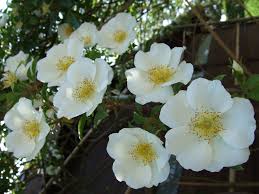Cultural Significance of Rosa laevigata in East Asia

#### Historical Context
**Ancient Chinese Gardens:**
Rosa laevigata, commonly known as the Cherokee Rose, has been an integral part of Chinese horticulture for centuries. In ancient China, the rose was often included in classical gardens designed for the imperial court and wealthy aristocrats. These gardens were not merely collections of plants but intricate landscapes that reflected philosophical and aesthetic principles, such as harmony, balance, and the unity of nature and man. The presence of Rosa laevigata in these gardens symbolized purity, beauty, and the elegance of nature. Its simple, white flowers contrasted with more elaborate floral species, creating a serene and contemplative atmosphere.
**Literature and Poetry:**
Rosa laevigata holds a special place in Chinese literature and poetry. Classical poets frequently used the rose as a metaphor for beauty and transient nature, often reflecting on the ephemeral quality of life and love. The simplicity and purity of Rosa laevigata’s blossoms made it a perfect symbol for unblemished beauty and virtuous qualities. In the Tang and Song dynasties, poets such as Li Bai and Su Shi composed verses that celebrated the ethereal beauty of the rose, cementing its cultural and literary significance.
#### Symbolism and Meaning
**Purity and Innocence:**
In East Asian cultures, the white flowers of Rosa laevigata are often associated with purity and innocence. This symbolism is rooted in the flower’s pristine white petals, which are seen as untainted and immaculate. In Chinese culture, white is a color of mourning but also represents purity and new beginnings. Rosa laevigata’s white blooms can therefore symbolize both the remembrance of the deceased and the hope for renewal and purity in life.
**Love and Romance:**
Rosa laevigata is also a symbol of love and romance in East Asian culture. Unlike the red roses that symbolize passionate love in Western cultures, the white roses of Rosa laevigata signify a pure and sincere form of love. This symbolism is often reflected in traditional wedding ceremonies and romantic literature, where the flower represents unblemished and eternal love. The rose’s delicate and graceful appearance further reinforces its association with romantic ideals.
**Resilience and Endurance:**
The hardy nature of Rosa laevigata, which can thrive in diverse environmental conditions, has made it a symbol of resilience and endurance. In East Asian culture, this characteristic is admired and often celebrated. The ability of the rose to withstand harsh conditions and continue to bloom beautifully is seen as a metaphor for the human spirit’s capacity to endure hardships and emerge stronger. This symbolism is particularly resonant in regions that experience extreme weather conditions, where the rose’s survival represents hope and perseverance.
#### Traditional Uses
**Medicinal Applications:**
Rosa laevigata has been used in traditional Chinese medicine for centuries. The fruit of the rose, known as the hip, is rich in vitamin C and other beneficial compounds. It has been used to treat a variety of ailments, including digestive disorders, inflammation, and respiratory issues. The medicinal use of Rosa laevigata underscores its cultural importance beyond its aesthetic value. Traditional healers often use the rose hips in teas, tinctures, and poultices, leveraging its natural properties to promote health and wellness.
**Culinary Uses:**
In addition to its medicinal applications, Rosa laevigata has culinary uses in East Asian cuisine. The petals and hips are sometimes used to flavor dishes, adding a subtle floral note. Rose hip jelly, tea, and syrups are popular traditional recipes that utilize the fruit’s high nutrient content. The incorporation of Rosa laevigata into culinary traditions highlights the versatility and cultural integration of the plant in everyday life.
#### Religious and Spiritual Significance
**Buddhism and Taoism:**
Rosa laevigata also holds spiritual significance in Buddhism and Taoism, two major philosophical and religious traditions in East Asia. In Buddhism, the rose’s simple and pure appearance is often seen as a symbol of enlightenment and the transient nature of life. The white petals represent the purity of the Buddha’s teachings and the clarity of mind required for spiritual awakening. In Taoism, the rose embodies the principle of wu wei, or effortless action, where nature’s beauty and harmony are achieved without force. The natural and unpretentious beauty of Rosa laevigata aligns with Taoist ideals of simplicity and living in harmony with the natural world.
**Feng Shui:**
In the practice of Feng Shui, Rosa laevigata is believed to bring positive energy and harmony to a space. The placement of the rose in gardens or homes is thought to enhance the flow of qi, or life force, creating a balanced and auspicious environment. The flower’s association with purity and resilience also makes it a popular choice for enhancing health and well-being in Feng Shui practices. By incorporating Rosa laevigata into living spaces, practitioners aim to cultivate a serene and harmonious atmosphere that promotes both physical and spiritual health.
#### Cultural Celebrations and Festivals
**Festivals and Ceremonies:**
Rosa laevigata often features in cultural celebrations and festivals in East Asia. During the Chinese New Year and other significant cultural events, the rose is used in decorations and floral arrangements to symbolize new beginnings and the renewal of life. Its presence in these celebrations underscores its cultural importance and the deep-rooted appreciation for its beauty and symbolic meanings.
**Traditional Crafts:**
The rose is also represented in traditional East Asian crafts, such as painting, embroidery, and porcelain design. Artists often depict Rosa laevigata in their works to convey themes of beauty, purity, and resilience. These artistic representations not only celebrate the rose’s aesthetic qualities but also preserve and perpetuate its cultural significance. The intricate depictions of Rosa laevigata in traditional art forms highlight the plant’s enduring appeal and its role as a cultural icon.
#### Conclusion
Rosa laevigata’s cultural significance in East Asia is multifaceted, encompassing historical, symbolic, medicinal, and spiritual dimensions. Its presence in ancient Chinese gardens, literature, and traditional medicine underscores its deep-rooted importance in the region’s cultural heritage. The symbolism of purity, love, and resilience associated with the rose resonates across various aspects of East Asian life, from religious practices to culinary traditions. Understanding the cultural significance of Rosa laevigata provides a comprehensive appreciation of this beautiful and resilient plant, highlighting its unique role in East Asian culture and its enduring legacy.
### Cultural Significance of Rosa laevigata in East Asia (Part 2)
#### Representation in Art and Literature
**Visual Art:**
Rosa laevigata is a popular subject in East Asian visual art, particularly in traditional Chinese painting and Japanese ukiyo-e prints. Its elegant, white blossoms are often depicted in works of art that emphasize natural beauty and simplicity. In Chinese brush painting, the rose is frequently portrayed with meticulous attention to detail, capturing its delicate petals and vibrant green leaves. These paintings often carry deeper meanings, using the rose as a symbol of purity, resilience, and the transient nature of life. In Japan, ukiyo-e artists have also depicted Rosa laevigata, highlighting its aesthetic appeal and cultural significance.
**Literary References:**
The cultural importance of Rosa laevigata is also evident in East Asian literature. In classical Chinese poetry, the rose is often used as a metaphor for noble qualities and virtuous behavior. Poets like Bai Juyi and Li Qingzhao have written about the rose, using its beauty and resilience as symbols of moral integrity and inner strength. The rose’s presence in literature extends to prose and folklore, where it is featured in stories that convey lessons about purity, love, and endurance. These literary references contribute to the rose’s esteemed status in East Asian culture.
**Modern Interpretations:**
In contemporary art and literature, Rosa laevigata continues to inspire creators. Modern poets and writers draw on the traditional symbolism of the rose to explore themes of beauty, nature, and human experience. Visual artists incorporate the rose into diverse media, from paintings and sculptures to digital art, often reinterpreting its classic imagery in innovative ways. This ongoing engagement with Rosa laevigata in modern cultural expressions underscores its lasting significance and adaptability to new artistic contexts.
#### Economic and Agricultural Impact
**Horticulture and Trade:**
Rosa laevigata plays a role in the horticultural industry in East Asia. Its popularity as an ornamental plant drives demand in the gardening and landscaping sectors. Nurseries cultivate and sell Rosa laevigata, contributing to local economies and promoting biodiversity. The rose is also traded internationally, reflecting its global appeal and cultural value. In regions where Rosa laevigata has been naturalized, such as the southeastern United States, it has become a part of the local horticultural heritage, further extending its economic impact.
**Traditional Agriculture:**
Historically, Rosa laevigata has been cultivated in traditional agricultural systems in East Asia. Farmers grew the rose not only for its aesthetic and medicinal properties but also for its practical uses. The plant’s robust growth and adaptability made it a valuable addition to agricultural landscapes, providing erosion control and enhancing soil quality. The integration of Rosa laevigata into traditional farming practices highlights its versatility and the practical benefits it offers alongside its cultural significance.
**Economic Benefits of Rose Products:**
The economic importance of Rosa laevigata extends to the production and sale of rose-derived products. Rose hips, known for their high vitamin C content and health benefits, are harvested and processed into various products, including teas, jams, and supplements. These products are sold both domestically and internationally, contributing to the economy and promoting the health benefits of traditional East Asian remedies. The commercial use of Rosa laevigata in the health and wellness industry underscores its economic value and cultural heritage.
#### Education and Conservation
**Botanical Education:**
Rosa laevigata is an important subject in botanical education in East Asia. It is studied for its unique botanical characteristics, ecological adaptations, and cultural significance. Educational institutions, from primary schools to universities, incorporate the rose into their curricula, teaching students about its biological properties and historical context. Botanical gardens and research institutions also focus on Rosa laevigata, conducting studies that contribute to the broader understanding of the species and its role in East Asian ecosystems.
**Conservation Efforts:**
Conservation efforts aimed at preserving Rosa laevigata and its natural habitats are critical to maintaining its cultural and ecological significance. In China and other parts of East Asia, conservationists work to protect wild populations of Rosa laevigata, ensuring that the plant continues to thrive in its native environment. These efforts often involve habitat restoration, seed banking, and public education initiatives. The conservation of Rosa laevigata is not only important for preserving biodiversity but also for maintaining the cultural heritage associated with the rose.
**Cultural Heritage Preservation:**
The preservation of Rosa laevigata is intertwined with broader efforts to protect and promote East Asian cultural heritage. Cultural heritage organizations and botanical gardens often collaborate to showcase the historical and cultural significance of the rose. Exhibitions, educational programs, and cultural events highlight the role of Rosa laevigata in East Asian history and traditions. These initiatives help to raise awareness about the importance of preserving the rose and its cultural legacy for future generations.
#### Social and Community Impact
**Community Gardening and Urban Green Spaces:**
Rosa laevigata is a popular choice for community gardening projects and urban green spaces in East Asia. Its resilience and low maintenance requirements make it an ideal plant for community-led gardening initiatives. These projects not only beautify urban environments but also foster community engagement and social cohesion. The presence of Rosa laevigata in public gardens and parks provides residents with access to green spaces and opportunities to connect with nature, promoting physical and mental well-being.
**Cultural Festivals and Public Celebrations:**
Rosa laevigata features prominently in cultural festivals and public celebrations across East Asia. During festivals such as the Chinese New Year and the Mid-Autumn Festival, the rose is used in decorations and floral displays that enhance the festive atmosphere. Public celebrations often include cultural performances, exhibitions, and workshops that highlight the significance of Rosa laevigata. These events provide opportunities for communities to come together and celebrate their cultural heritage, strengthening social bonds and fostering a sense of shared identity.
**Educational Outreach and Public Awareness:**
Educational outreach programs focused on Rosa laevigata aim to increase public awareness about the rose’s cultural, ecological, and economic importance. Botanical gardens, museums, and cultural institutions organize workshops, lectures, and guided tours that educate the public about the history and significance of Rosa laevigata. These programs often target diverse audiences, from school children to adults, ensuring that knowledge about the rose is passed on to future generations. Public awareness campaigns also emphasize the importance of conservation and sustainable practices, encouraging communities to protect and preserve Rosa laevigata and its natural habitats.
#### Conclusion
The cultural significance of Rosa laevigata in East Asia is profound and multifaceted. From its historical role in ancient gardens and literature to its contemporary presence in art, horticulture, and community life, the rose embodies a rich tapestry of cultural meanings and practical uses. Its symbolism of purity, love, and resilience resonates deeply within East Asian traditions, while its economic and ecological contributions underscore its value beyond aesthetics. Educational and conservation efforts further highlight the importance of preserving Rosa laevigata as both a natural and cultural treasure. By understanding and appreciating the diverse aspects of Rosa laevigata’s cultural significance, we can ensure that its legacy continues to inspire and enrich future generations.

